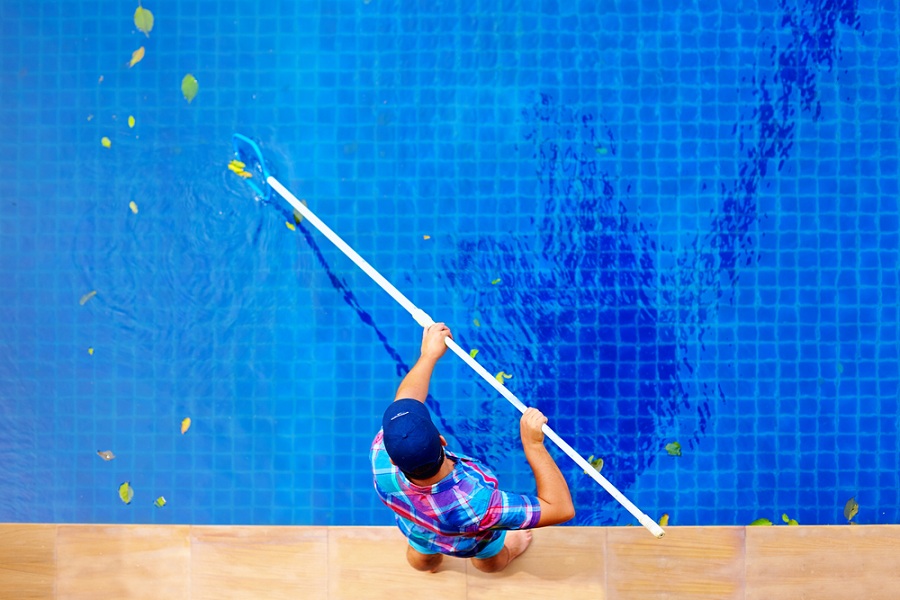It’s finally here! Pool season has arrived!
Now that the weather is warming up, it’s time to enjoy spending time outdoors with family and friends.
But what about cleaning your pool? Where should you start before taking the first dip?
While plenty of chemicals are available to kill bacteria and algae, these chemicals can damage your pool and water system over time. In addition, using chlorine alone isn’t effective against viruses, such as norovirus.
So, what do you do to ensure your stale pool water is healthy and clean?
You don’t have to spend hours scrubbing your pool to prepare.
Instead, you can do simple things to get your pool clean quickly without harming your pool or water system.
Here are five easy steps to clean your pool:
1. Diagnose Obvious Issues Correctly
First, you should diagnose any issues with your pool water and surfaces before buying chemicals to fix them. The most common issues with stale pool water include:
- Floating debris: leaves, twigs, bugs
- Debris & scum on the pool's surfaces and floor: sand, dirt, twigs, et al
- Biological contamination: If your pool surface and/or water is green in color or spotted with black circles, then the culprit is algae. If you see a yellow, red, or brown color or deposits, then the problem is often bacteria.
- Chlorine and pH levels are way off. You can use a water test strip to quickly see where you stand.
2. Remove Debris From All Pool Surfaces
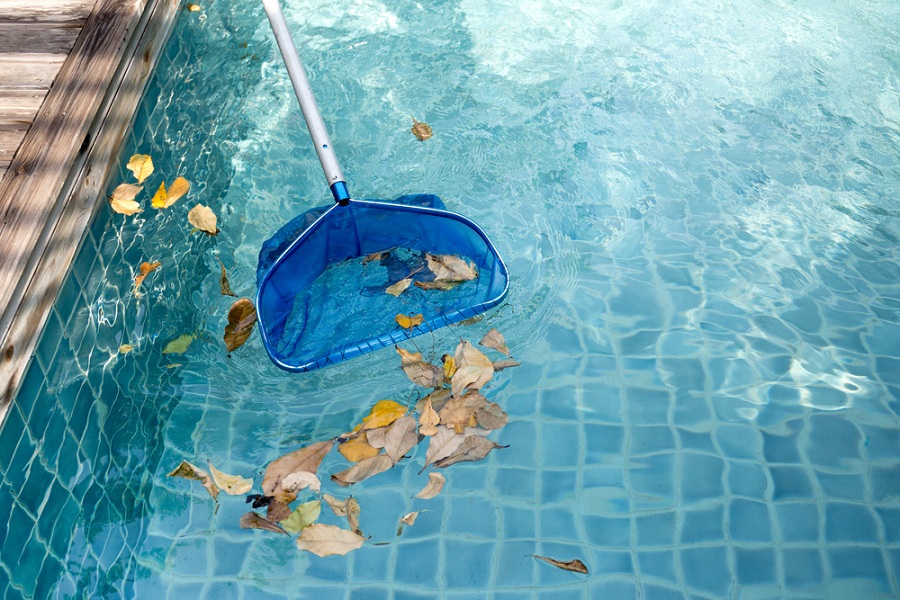
Use a nylon pool brush and pool net to remove as much floating and sunken debris as you can from your pool and its surfaces.
Then, scrub all pool surfaces with a pool brush to remove any stuck-on scum and grime.
3. Shock Your Pool
Bacteria and algae growth are the most common biological problems with pool water that has been left unattended for months.
To kill these infections, you will want to shock your pool with chlorine. If you suspect bacterial contamination, you may also want to use a bromine solution to address that.
Chlorine and bromine are safe to use in the right concentrations, but you need to take care and read instructions carefully to avoid getting chemical burns or putting too much into the water, risking eye and skin irritation.
When adding chlorine to your pool, always follow the directions on the label. If you’re unsure whether you follow the directions correctly, contact your local pool store or pool service company for advice.
Be sure to read the directions thoroughly before starting to add chlorine to your pool.
4. Get Your pH Level Right
The next step is to get the pH level of your pool water back in-range.
pH stands for potential hydrogen. It measures the amount of acidity or alkalinity in your pool.
To ensure that your pool stays free of algae and bacteria, you need to maintain a specific range of pH level in your pool, normally between 7.0 and 8.0.
For example, a pool with high amounts of calcium carbonate (a type of salt) will have a higher PH level.
Using a test strip as your guide, add muriatic acid or an alkaline solution to your pool water per the instructions to get your pH back in-range.
5. Run Your Pool Filter & Automatic Pool Cleaner For 24 Hours
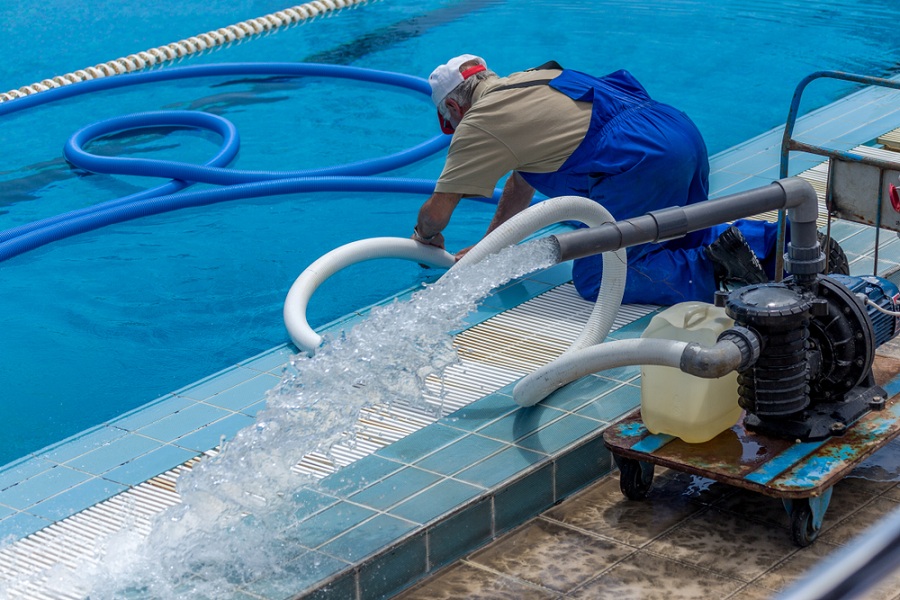
After performing steps 1-4 above, attach and insert your automatic pool cleaner and then run your pool filter system for the next 24 hours straight to thoroughly mix the water and rid it of debris.
After 24 hours, re-test your pool water for chlorine and pH. Adjust chemicals as needed.
(If Needed): Remove Dirt, Objects And Debris From Around Your Pool
Finally, remove excess dirt and debris from around your pool and from your pool deck.
This includes leaves, grass clippings, and other debris that could collect around your pool.
Removing this debris helps prevent algae growth. Also, removing containers of standing water from around your pool prevents mosquitoes from breeding.
What Makes A Stale Swimming Pool Dirty?
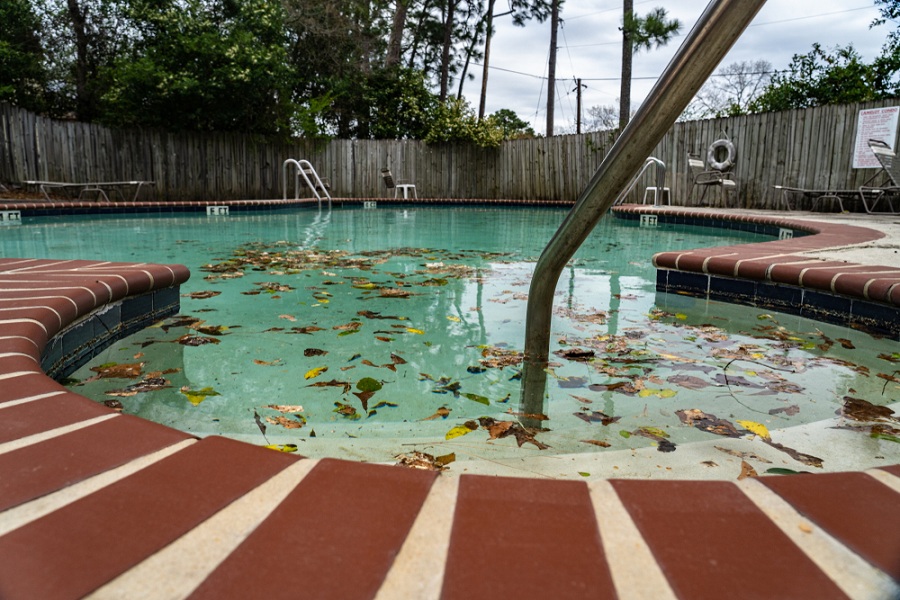
Swimming pools are filled with water, which makes them dirty very quickly.
Even when they’re new, they often get dirty within just a few days.
But why do pools get dirty? Here are some things that make pools dirty:
1. Bacteria
Bacteria are microscopic organisms that live everywhere in nature.
But, they don’t usually pose any health risks unless there’s something wrong with their environment.
That’s why many people think that swimming pools are entirely germ-free environments.
However, this isn’t true.
Bacteria can grow in almost every part of a swimming pool.
And, because they multiply rapidly, they can cause serious health issues if they build up in large numbers.
2. Algae
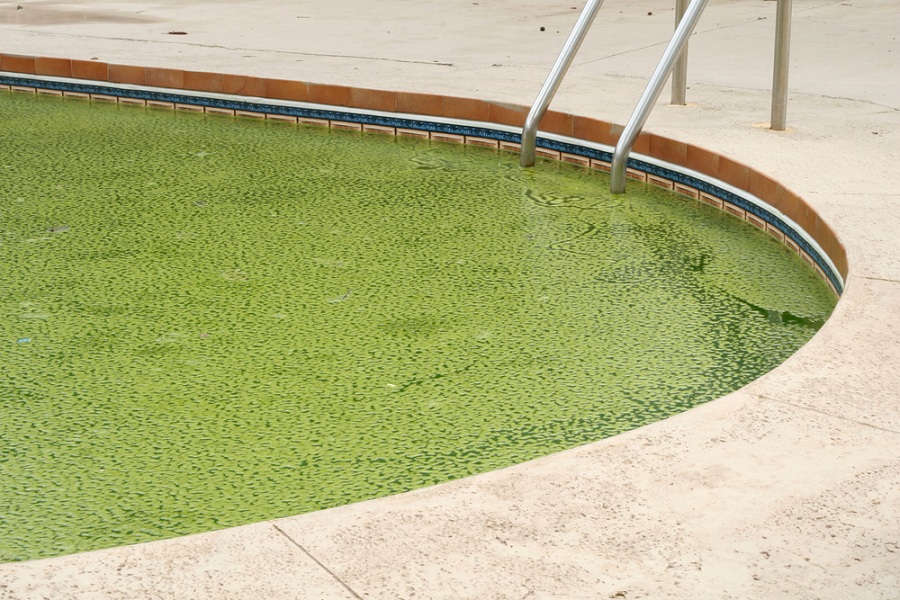
Algae are microscopic plants that live in almost every natural body of water.
And, like bacteria, they don’t usually cause any harm unless there’s something wrong in their habitat.
So, it’s no surprise that most people assume swimming pools are safe places to swim.
Unfortunately, this isn’t true either.
Like bacteria, algae can grow in almost every swimming pool area. They can form thick layers of green slime on the water’s surface.
These slimy green patches are called scum.
3. Organic Matter
Because swimming pools contain so much water, they tend to smell bad.
Even when they’re brand new, pools often smell musty or rotten.
The reason is simple — water contains lots of organic material.
When it gets wet, this material decomposes into various gases. These gases then rise through the water column and fill the air above the pool.
When the air becomes saturated with these gases, it smells foul.
4. Leaves and Grass Clippings
Leaves and grass clippings fall into the water as you mow the lawn.
As they float around in the water, they eventually sink to the bottom of the pool.
Over time, the leaves and grass gradually accumulate at the bottom of the pool, forming a layer of debris.
This layer of debris collects dirt particles from the surrounding soil. And, over time, the dirt accumulates at the bottom of the swimming pool.
This layer of dirt is called silt. It’s not harmful, but it does affect how clear the water looks.
5. Chemical Additives
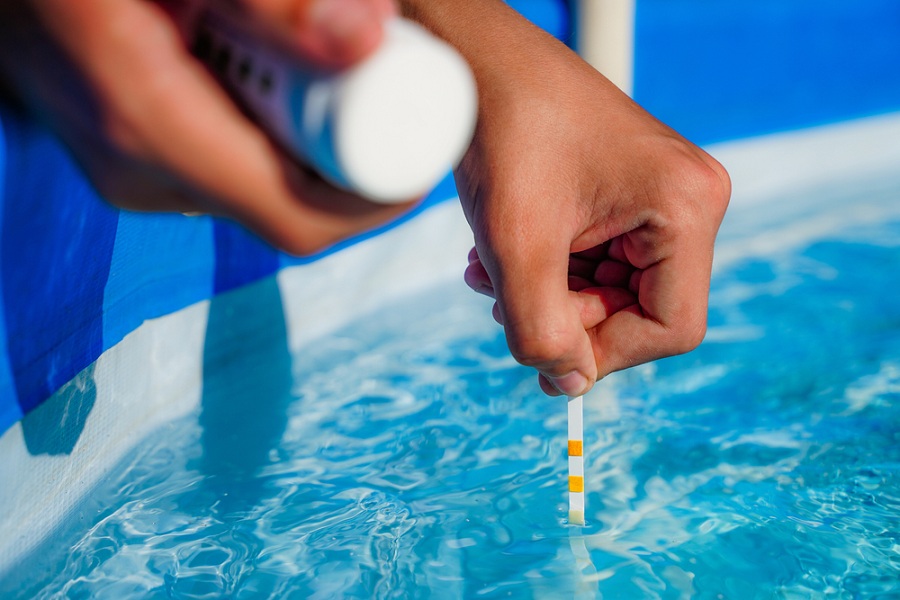
Some swimming pool owners add chemicals to their pool water to free it from algae and other contaminants.
Although these chemical additives kill germs and bacteria, they also change the pH level of the water.
For example, chlorine kills germs by breaking down their cell walls. But, it also changes the PH level of the water. The PH level is an important indicator of whether a swimming pool has too much or too little acidity.
If the PH level of a swimming pool is too high, the water will be very alkaline. This makes it hard for your skin to absorb calcium and magnesium, essential minerals for healthy bones.
If the PH level is too low, the water won’t have enough acidity to break down the dirt and debris collected at the tank’s bottom.
6. Leaks
Leaks in pipes can allow contaminated water to enter the pool.
This problem is especially common with older pools. As the pool ages, its plumbing system may become worn out.
In addition, some swimming pools use plastic piping instead of metal piping. However, over time, the plastic pipes can crack and leak.
7. Swimming Pool Equipment
Swimming pool equipment, filters, pumps, heaters, etc., all need periodic maintenance.
However, if they aren’t properly maintained, they can damage the pool. For instance, if a heater doesn’t work correctly, it could burn up the pool liner. Or, if a filter fails, it might contaminate the pool water with dangerous levels of bacteria.
8. Poor Maintenance
Poor maintenance can lead to severe problems. For example, it can quickly deteriorate if you don’t maintain your swimming pool regularly.
A neglected pool can develop leaks, cracks, rusting pipes, poor circulation, and more.
Tips to Keep Your Pool Clean
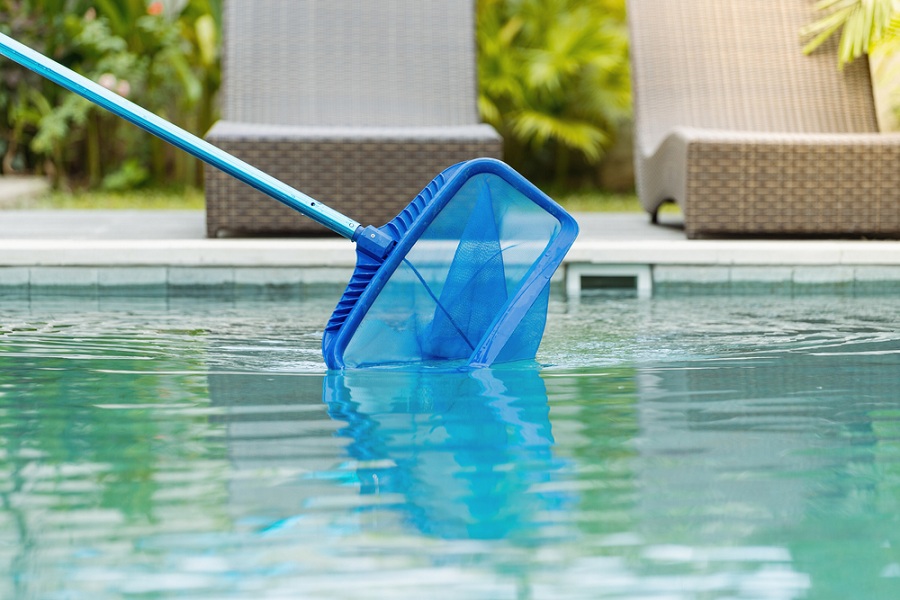
1. Use a Vacuum & Skimmer To Remove Debris
Use a suction-side pool vacuum to remove debris from the bottom of your pool. Keep your pool skimmer baskets empty to remove debris before it falls to the bottom.
2. Maintain Your Pool Filter
Regularly inspect and replace or clean your pool filtration system.
3. Check Water Level
Check the water level every day. Make sure it stays just at the top edge of the skimmer basket. If the water level remains much higher than that, you may have a backup in your pool filtration system.
4. Change Filter Bags
Change your automatic pool cleaner filter bag no less than once a month. We recommend checking daily and weekly.
5. Inspect Pumps Monthly
Check your pool pump monthly to make sure it’s working well. If you hear a high-pitched whine or low-pitched rumble, call your local pool store for a maintenance visit to diagnose.
6. Test Alkalinity
Test the pH level of your pool water every one or two weeks at a minimum.
7. Monitor Temperature
Monitor your pool water’s temperature to ensure it stays within safe limits. If the temperature exceeds 85 degrees Fahrenheit for extended periods, then algae will bloom. In this case, you will need to shock your pool regularly until the temperature subsides.
8. Remove Scum
Clean scum off the surface of your pool using a scrub brush.
9. Maintain Skimmers
Clean the skimmer baskets once per week.
10. Wipe Down Surfaces
Wipe down surfaces like benches, diving boards, and other areas around your pool.
Frequently Asked Questions
Q: How often should I clean my pool?
A: It depends on how dirty your pool is. A clean pool needs less frequent cleaning than a dirty one.
Q: What do I need to clean my pool?
You’ll need a bucket of warm water, a sponge or mop, a garden hose, and a few cleaner rinses.
Q: Can I use chemicals to clean my pool? Should I use them?
A: Yes! Using chemicals helps keep your pool clean and healthy. However, you must be careful not to overuse them.
Q: Is there anything else I need to know about cleaning my pool?
A: Yes. Always read the label before applying any chemical product to your pool.
Q: Are there any safety concerns associated with cleaning my pool?
A: No. There are no health risks involved in cleaning your pool.

